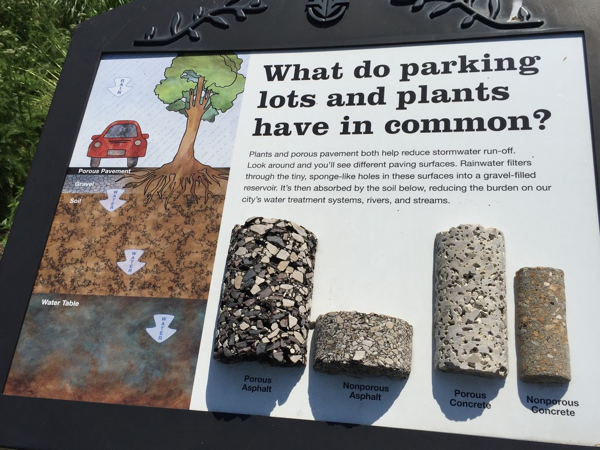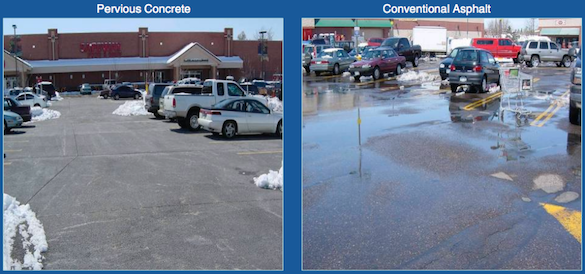We believe that a vigorous community discussion of multiple stormwater components — a matrix of possibilities and their associated strengths and weaknesses — will help us find a sustainable balance between cost, stormwater management, and quality of life in Winnetka. Our 100-year stormwater plan deserves 100-year quality thought!
Here are several ideas we’ve thought of. If you have other suggestions, please email them to info@savecrowislandwoods.org, or post them below!
Hybrid Under/Above Ground Storage @ New Trier Baseball Fields
Put underground storage underneath New Trier Baseball field(s) linked to envisioned Duke Childs wetland or a wetland in the back of property. Put baseball fields back on top, raised up by a few feet. Baseball fields are about 3 acres apiece, so 6 foot deep storage under one field ~= 18 acre feet of storage (giving you more than the 15.9 AC-FT storage envisioned for Crow Island).
Upside:
- Winnetka gets storage for biggest storms, without giving up valuable usable space — this plan would probably make the baseball fields much more available after wet weather, and might well create completely new playable sport field space on landfill (still cheaper to put dredged dirt on landfill than haul away).
- New Trier doesn’t necessarily lose Duke Childs. If this removes need to make playfield improvements to landfill, then this saves $2.3+ Million.
- Wetland could be moved to back of property… farther away from residents who might be worried about deep water/proximity to deep water near residences
- New Trier gets fields which will be playable in more weather.
- Could easily be combined with additional wetland built into par 3 golf club
- Simplifies: more water stored in one place
- Flexibility: could drain three different ways: (1) as proposed by strand, (2) into forest preserve between Golf Course and Forest Way, or (3) into forest preserve just west of the park service center.
- Doesn’t require pipe through Sunset Road/private land
Downside: ~$2.5M without land-fill playfields, ~$5M including new field space.
- Underground storage more expensive than above ground (est. $4M underground vs. $2M Crow Island storage)
- Adds 2 blocks to pipe length northwards from south Winnetka, ~1 block farther west. $3M?
- Would remove at least baseball one field from use for at least part of a playing season, but possibly reduce LAX/soccer unavailability if Duke Childs wetland is not chosen.
Leverage Existing Crow Island Wetland
Rather than creating a second wetland at Crow Island, can we better use the existing Crow Island wetland to provide the desired water quality benefits? Improve ecosystem & buffer water in big storms by utilizing underground storage (for example, under grass area, Crow Island Blacktop, park road, etc.) without costing any land. Run water from NW corner of Crow Island ark down Willow Road to meet Strand plan at Willow/Hibbard.
Upside:
- Winnetka gets storage for biggest storms, without giving up additional usable space
- Improve diversity of marsh ecosystem, to always having running water… reduce mosquitos, etc.
- Might improve usability of Park District and District 36 fields during typical bad weather, and reduce standing water along NE side of woods.
- Saves piping distance, because (1) marsh covers part of distance above ground, (2) underground storage covers part of distance below ground, and (3) culvert can diagonal more inexpensively across open parkland without significant long-term damage to trees or roads. Or could using longer, existing easement across north end of Woods.
- Doesn’t require pipe through Sunset Road/private land
Downside: $2M additional cost
- Marsh would be slightly closer to Crow Island School (with positives & negatives thereof).
- Underground storage about 2x cost of above ground (est. $4M underground vs. $2M Crow Island storage)
Golf Course
Steve Lesnik, Winnetka resident and Chairman of a company which has built and managed hundreds of golf courses, explains that courses are now commonly designed to absorb stormwater run-off without crippling long-term shut-downs of the sort that shut down Winnetka’s course during recent storms. Realistic solution for tree streets, but a bit of a challenge for water from south Winnetka. Could drain into small forest preserve area SW of golf course.
Upside:
- Add interest & challenge to Winnetka course (adding potential revenue) without obviously adding a stormwater-only wetland
- Significant above ground without depth limitations because it’s far away from residential areas
- Would improve playability after storms leading to increased revenue
- Could make Skokie/Washburne underground storage unnecessary
- Minimizes commitment from Forest Preserve
Downside:
- Farther/slightly uphill from south Winnetka such that it might require pumping. If a separate solution could be found for south Winnetka, this might be the cheapest solution.
Pervious Pavement

One of the strongest arguments Strand presented against “green infrastructure” was a low percentage of projected rollout. That’s a little disingenuous because the Village is itself the biggest owner of non-pervious pavement — nearly 200 acres of roads, sidewalks & parking lots. Every acre of pervious roads, sidewalks & parking lots could add several acre feet of road storage capacity, without transit-crippling curb bump-outs. If each of acres could store just one foot of water, that would give us more capacity than we’re currently struggling to scare up!
And — since we don’t need to achieve all of this protection at once (there’s only a 1/100 chance of a 100-year flood happening this year) — we can gradually replace roads at when they need replacement, so using pervious materials adds more modestly to cost, and spreads the burden over a number of years.
Plus, it benefits trees & landscaping. Porous cement concrete sidewalks have been found to reduce pavement uplift from roots. And, they improve safety by drying much, much faster after rain and snow. Here’s a photo showing how pervious & non-pervious surfaces compare the morning after a 12″ snow.

Simpler Solutions
Strand has shown us something we could do without pumps. Can we do it without the giant pipes that are causing so much angst and account for 70% of the total cost?
We’re all aware that even well-planned complicated engineering solutions often fail because it becomes too hard to forsee complications or provide true redundancy. Consider, for instance, a simple tree, falling in the storm, clogging the culvert, and redirecting a whole town’s worth of stormwater into neighboring homes in the middle of the night.
Are there simpler, local solutions which don’t even require substantial conveyance? Rather than pumping across town, we might store stormwater underground and use it to water our lawns, wasting less clean water.
Vacant parcels — considered promising, but challenging to find in the right spot… Zillow’s got ‘em: 7 acres available near the south Winnetka flood epicenter of Sunset/De Windt And because 100-year floods literally don’t happen every day, we have time to identify optimal properties and pick them up as they become available.
Rain gardens may not make sense in the tree streets, but in south Winnetka where lot sizes are bigger several water-conscious homeowners have have have gone from always flooded to no flood through smart landscape architecture alone.
Strand’s deck notes 50-gallon rain barrels offer limited storage, but didn’t mention how other towns are becoming zero net-runoff communities. In Cambridge, MA installing an underground 10,000 gallon tank for stormwater is now a standard part of building a new home. We all agree that a couple of decades of building bigger houses has significantly compounded the flooding problem, so let’s consider some steps to keep from making it worse!
Indian Hill and Faith Hope were discarded, in part, because they couldn’t reasonably deal with all of south Winnetka’s water, but in combination with other solutions here, they might be able to play a part.
In Australia village roads are lowered by a couple of feet so that the roads themselves provide very cost-effective short-term stormwater storage and conveyance.
Porsche Contributes a Very Out of The Box Idea

Porsche contributes this “out of the box” idea which appeared in a 2016 brochure: build a mountain range west and northwest of the Chicago. This will create a more interesting skyline/horizon, elevating Chicago into the same league as Denver or Los Angeles as far as skylines are concerned. It will also make for much better skiing in winter and boating (in the spots where the dirt formerly was) in summer, and give people better reasons to live in the far west suburbs! Most importantly for the issue at hand, the new range’s rain shadow will also reduce rainfall in the city and its suburbs, leading to more sunny days, and fewer floods. Highest cost of the proposed solutions, but one which would transform the Windy City’s image!
Please do not make Crow Island Woods a wetland. It should be preserved as it is for a nature learning area for
the students of Crow Island. We are extremely lucky to have such a rare woodland attached to one of our
elementary schools. Please do not destroy it and its benefits for our children and the birds that frequent the area.